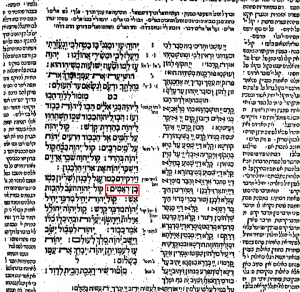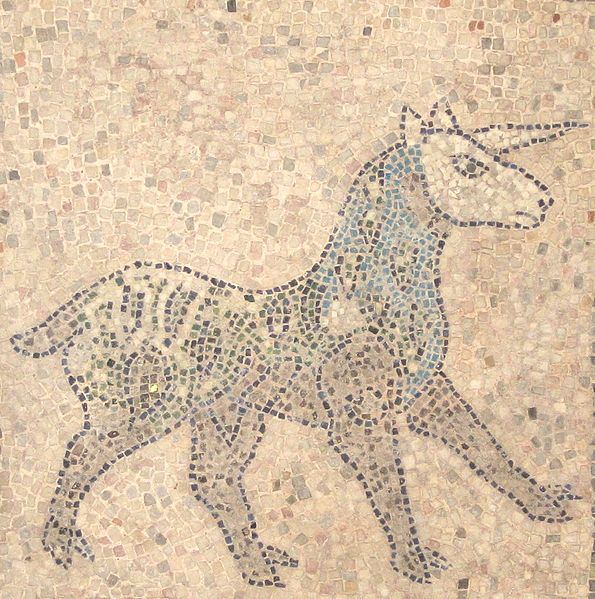If you have been reading posts at DOTB for very long you will already know that poking fun at our own religion is something that is done regularly. Not really because we have animosity towards Christianity but because if Christians can’t laugh at their own weirdness and mistakes then we’re in a world of hurt since we live a world that is increasingly more educated and sometimes more knowledgeable about Christianity than most Christians are. That of course brings me to a topic that one of the students in my church alerted me to; unicorns in the Bible.
At first I actually didn’t believe him….and then he said “well, in the King James Bible they are.” As soon as the KJV entered the conversation I knew I might learn something interesting. As you might already know, the KJV is a great source of interest for me. Not because I think it is “God perfect preserved Word in English,” but because for anyone who actually reads it, they are going to find some very strange things. Some of those I have already take the time to point out (or make jokes about) in my previous post on the KJV.
So without further adieu! Here are unicorns in the KJV.
- Numbers 23:22
God brought them out of Egypt; he hath as it were the strength of an unicorn.
Numbers 23:21-23 (in Context) Numbers 23 (Whole Chapter) Other Translations
- Numbers 24:8
God brought him forth out of Egypt; he hath as it were the strength of an unicorn: he shall eat up the nations his enemies, and shall break their bones, and pierce them through with his arrows.
Numbers 24:7-9 (in Context) Numbers 24 (Whole Chapter) Other Translations
- Deuteronomy 33:17
His glory is like the firstling of his bullock, and his horns are like the horns of unicorns: with them he shall push the people together to the ends of the earth: and they are the ten thousands of Ephraim, and they are the thousands of Manasseh.
Deuteronomy 33:16-18 (in Context) Deuteronomy 33 (Whole Chapter) Other Translations
- Job 39:9
Will the unicorn be willing to serve thee, or abide by thy crib?
Job 39:8-10 (in Context) Job 39 (Whole Chapter) Other Translations
- Job 39:10
Canst thou bind the unicorn with his band in the furrow? or will he harrow the valleys after thee?
Job 39:9-11 (in Context) Job 39 (Whole Chapter) Other Translations
- Psalm 22:21
Save me from the lion’s mouth: for thou hast heard me from the horns of the unicorns.
Psalm 22:20-22 (in Context) Psalm 22 (Whole Chapter) Other Translations
- Psalm 29:6
He maketh them also to skip like a calf; Lebanon and Sirion like a young unicorn.
Psalm 29:5-7 (in Context) Psalm 29 (Whole Chapter) Other Translations
- Psalm 92:10
But my horn shalt thou exalt like the horn of an unicorn: I shall be anointed with fresh oil.
Psalm 92:9-11 (in Context) Psalm 92 (Whole Chapter) Other Translations
- Isaiah 34:7
And the unicorns shall come down with them, and the bullocks with the bulls; and their land shall be soaked with blood, and their dust made fat with fatness.
Uuuuuhhhh…..someone please tell me this is a joke.
What I really enjoy about unicorns in the KJV Bible is that no one seemed to have the good sense to change it in the modern revisions. One would think that as time moved on that the verbiage would be updated to reflect the non-mythical creature, which it is actually referring it.
What’s Happening here?
As it turns out not all of the Greek and Hebrew in the manuscripts available was easily translated. They were languages that were basically dead until the Renaissance came along and began reviving the study of classic Greek and other languages. Even though people were able to translate a lot of Greek and Hebrew in 1611, they certainly did not have the same ability that we have today. Since 1611, the information known about the biblical languages has grown 10-fold. And to top things off we have thousands upon thousands of non-biblical texts to glean knowledge from.
So what’s with the unicorn?
Well, in order to understand why the unicorn was chosen for the KJV translation we have to remember that many animals mentioned in the Bible were not native to the lands where the KJV was translated. So the translators had two choices in 1611. They could translate unicorn are a mythical horse-like beast with a single horn (which was common in the middle ages), or a another single-horned animal such as some African Rhinos. Most likely, the unicorn in the KJV is referring to a Rhinoceros. Some of the marginal notes from the 1611 might be helpful!

So why did they go with unicorn rather than rhino?
I think this question has a few answers. First, but probably not 100% likely, the translators actually believed that unicorns (as we imagine them today) existed. Secondly, the translations that came before 1611 were ambiguous. The LXX (Greek Septuagint, translated the Hebrew/Aramaic OT into Greek around 200BC) translated these verse referring to unicorns with the word μονόκερως which basically just means “one-horn.” The matter was worsened even more when Jerome compiled the Latin Vulgate and translates the word as unicornis, which is Latin for “one-horned one.” So, basically it is an undefined single-horned animal…..who probably looked like this:

In 1611, the word unicorn was translated (actually transliterated) straight into English since we have no equivalent; as “unicorn.” Not a bad idea, except that no one knew what a unicorn was. They DID have the Hebrew manuscripts and lexicons to work from but failed to know that the word was actually רְאֵם (which means wild ox). The Hebrew manuscripts that were used were part of collection called the Rabbinic Bible, which was basically a version of the Hebrew OT assembled by Ben Chayyim about 1525. It was the Masoretic text and commentaries that were available at the current time in history. Here is what it looked like in 1525.

As you can see, the word used in 1525 is exactly the same word used in some of the Tanak (Hebrew Bible) translations from the 20th century. I have a copy from 1972 which translated it as unicorn also, which was published by Sinai Publishing. My copy made by the Jewish Publication Society in 2003 translates the word as wild donkey. So, not only the KJV translators but also various Jewish translators translated this word as unicorn until somewhere after 1972. I find that to be remarkable.
Unicorn or Ox or Rhino?
The decision that needs to made here is what in the world does unicorn actually mean? What did the ancient writers envision as a unicorn? Some of the older lexicons describe it as a horned ox, or a horned ass (donkey). It also describes them as wild and untamed. We can see now how some fanciful creature was developed to fill this description. Most likely it was initially just referring to a Rhino, which would have been a known beast in the ancient world and also seems to fit the verses mentioned above.
It should be worth noting that a few things jump out of the verses above.
1) The unicorn is mentioned in tandem with bulls, calves, or similar creature. Possibly being in the same family of animal.
2) The mention of Egypt is accompanied with these references. The Rhino would have been very well known in Africa (the continent that Egypt is in), and are even depicted in ancient Egyptian writing.
3) The animal mentioned in the verses is mentioned because of it’s strength and the power of it’s horn. That sounds a lot like a Rhino.
While scholars may never know 100% what the original meaning is, I am putting my money on either Wild Ox or Rhino. The references to unicorn is not a bad translation because it is ambiguous and could refer to any single-horned animal. It is only rather late thinkers that have conceived of the unicorn being a majestic horse with a horn. In fact, even the art in the 13th century tended to depict the unicorn as a beautiful and majestic creature.


![Psalm 29.6 KJV 1611 [unicorns in the Bible] Psalm 29.6 KJV 1611 [unicorns in the Bible]](http://www.dustoffthebible.com/wp-content/uploads/2013/04/Psalm-29.6-KJV-1611-300x253.jpg)
“In 1611, the word unicorn was translated (actually transliterated) straight into English since we have no equivalent…” Unicorn was transliterated into English (mediated through the Old French from Latin) — but not in 1611. Etymology of the word unicorn shows its use in Middle English back into the 13th century. Its use in the language prior to 1611 is demonstrated by looking at the word unicorn earlier Bibles such as Wycliffe, the Tyndale Pentateuch, and the Geneva Bible.
https://archive.org/details/ThePentateuch/page/n291/mode/2up
Fair observation, however, most of the earliest Middle English references to unicorn are either Bibles or commentaries on the Bible, which is why I said what I said. To be clear, I did not intend to state that the 1611 KJV was the first English Bible to transliterate the word into English. A vast majority of the 1611 was unaltered from the Bishop’s Bible. Based on what I’ve been able to find, the word came into the English language as a biblical transliteration and I am inclined to believe that is how it was obtained in French also.
https://quod.lib.umich.edu/m/middle-english-dictionary/dictionary/MED48892
My primary point is that “transliterate” is not the best way to describe the use of a word that has already been used in a language for three or four hundred years. I think even “transliterate” was transliterated from the Latin, but we don’t describe ourselves as transliterating when we use it, because it has long since (though not 300 or 400 years) become part of our language.
That is a fair point. When the KJV team kept the wording were they aware that it was previously just a transliteration or did they treat it just like any other word that found it’s way into the English language? I am not sure there is an answer to be found here.